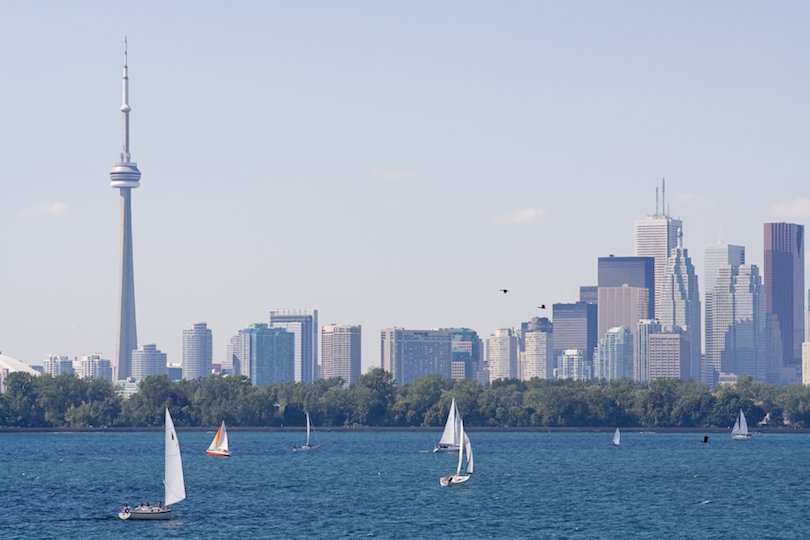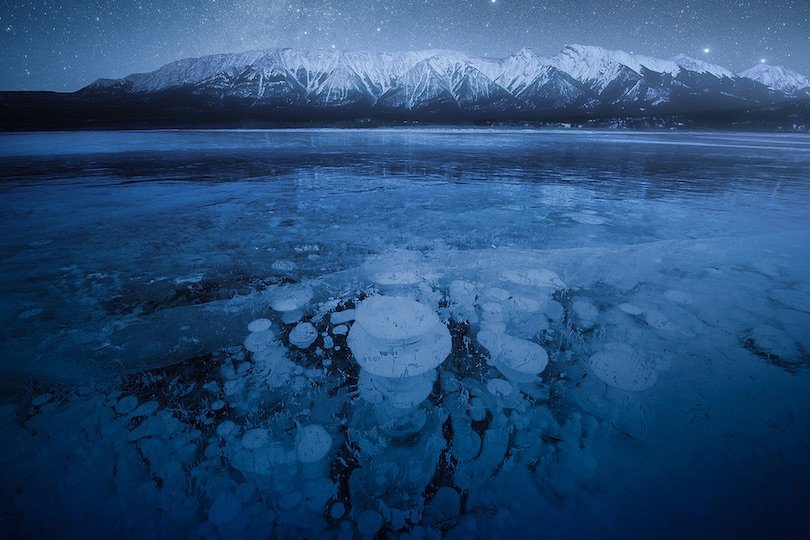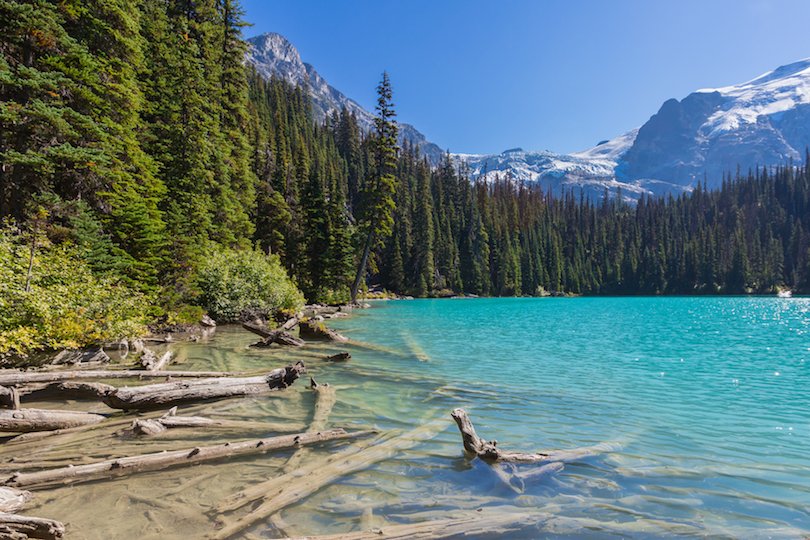12 Most Beautiful Lakes in Canada, specifically in British Columbia and Alberta, are truly breathtaking. This is not to say that the lakes in the eastern part of the country are unattractive – they have their own unique charm. Nevertheless, it is undeniable that the western lakes, with their turquoise waters and picturesque mountain ranges, are a sight to behold. If you are searching for a place to swim or go motor-boating, the eastern Canadian lakes are a great option. However, if you desire to paddle through serene waters in a remote wilderness, then heed the advice of Horace Greeley and head west.
Garibaldi Lake

Situated within a provincial park bearing its name, Garibaldi Lake embodies picturesque beauty, encompassed by majestic snow-capped mountains and verdant forests. Regrettably, individuals who prefer a sedentary lifestyle may never have the opportunity to witness this natural wonder. This is due to the fact that reaching the lake requires embarking on a moderately challenging 18-km (11-mile) hike, which takes approximately five to six hours to complete. To fully immerse themselves in the breathtaking allure of the lake, many individuals opt to arrange overnight camping accommodations in advance.
Lake Superior

Lake Superior, formed by volcanic activity, has existed for millions of years. It is the largest of the Great Lakes and one of the largest freshwater lakes globally. The southern part of the lake, which separates Canada and the United States, is referred to as “the Great Lakes graveyard” due to the numerous shipwrecks, particularly around Whitefish Point. The SS Edmund Fitzgerald, which sank in 1975, is the most well-known shipwreck. This region is now a protected underwater area.
Lake Ontario

Lake Ontario, the namesake of the Canadian Province it borders, may be the smallest of the Great Lakes, but it still ranks as the world’s 14th largest lake. Situated beneath Niagara Falls, the lake serves as the Great Lakes’ connection to the Atlantic Ocean, ultimately flowing into the St. Lawrence River. The lake’s shores are adorned with majestic lighthouses, and it is dotted with numerous islands. Toronto is the largest city on the Canadian side. Despite the challenge, many swimmers attempt to cross the 51 km (32 miles) stretch of the lake, but only around 50 have successfully completed the feat.
Abraham Lake is one of the 12 Most Beautiful Lakes in Canada
 Abraham Lake, situated on the North Saskatchewan River in Alberta, is a relatively recent addition to the region’s lakes. Unlike many other lakes in the area that were formed by glacial activity, Abraham Lake came into existence in 1972 when the river was dammed. Despite its man-made origins, the lake boasts stunning glacial blue waters. The Canadian Rockies experience frigid temperatures during the winter, which provides the perfect conditions to witness the lake’s renowned bubble phenomenon. As the freezing water interacts with decaying plants, methane is released, causing the water to bubble. It is important to note that methane is highly flammable, so it is advised not to smoke near the ice if you are in the vicinity.
Abraham Lake, situated on the North Saskatchewan River in Alberta, is a relatively recent addition to the region’s lakes. Unlike many other lakes in the area that were formed by glacial activity, Abraham Lake came into existence in 1972 when the river was dammed. Despite its man-made origins, the lake boasts stunning glacial blue waters. The Canadian Rockies experience frigid temperatures during the winter, which provides the perfect conditions to witness the lake’s renowned bubble phenomenon. As the freezing water interacts with decaying plants, methane is released, causing the water to bubble. It is important to note that methane is highly flammable, so it is advised not to smoke near the ice if you are in the vicinity.
Emerald Lake

Emerald Lake, the largest lake in Yoho National Park in the Canadian Rockies, is best visited in July. This is because during this time, the emerald green water is at its most beautiful. The stunning color of the lake is derived from the presence of powdered limestone in the water. Typically, the lake remains frozen until June, making July the ideal month to witness its vibrant hue. However, if you happen to visit during winter, the lake offers an excellent opportunity for cross-country skiing.
Peyto Lake
 Peyto Lake’s deep turquoise blue waters provide a striking contrast to the surrounding mountains, creating a picturesque scene. This lake, located in Banff National Park, is renowned for its unique color, making it a popular spot for photographers. The ideal location to admire this elongated body of water is from Bow Point on the Icefields Parkway, which traverses western Alberta. For photographers looking for alternative perspectives, they can hike up from there or even descend to the lake itself.
Peyto Lake’s deep turquoise blue waters provide a striking contrast to the surrounding mountains, creating a picturesque scene. This lake, located in Banff National Park, is renowned for its unique color, making it a popular spot for photographers. The ideal location to admire this elongated body of water is from Bow Point on the Icefields Parkway, which traverses western Alberta. For photographers looking for alternative perspectives, they can hike up from there or even descend to the lake itself.
Maligne Lake

If you are in search of picturesque Canadian lakes, Maligne Lake is a perfect choice. This stunning lake, characterized by its mesmerizing glacier blue waters, is situated amidst the majestic snow-covered Canadian Rockies in Jasper National Park, Alberta. Maligne Lake, pronounced as meLEEN, holds the distinction of being the largest lake in the park. Stretching over a length of 21 km (13 miles), it stands as the longest lake in the Canadian Rockies. Exploring the lake can be done by embarking on a scenic hike or opting for a boat ride to Spirit Island, a small yet enchanting island adorned with abundant trees.
Lake Louise
 Lake Louise, a picturesque destination resort, is renowned as the epitome of Canada’s stunning lakes. Its name, derived from Princess Louise Caroline, Queen Victoria’s daughter, adds to its regal charm. The awe-inspiring beauty of Lake Louise is best captured by its turquoise blue water sourced from the majestic Victoria Glacier. During the summer, one can take a daring plunge into the cold waters or embark on a scenic hike around the lake. In winter, the resort offers excellent skiing opportunities for enthusiasts.
Lake Louise, a picturesque destination resort, is renowned as the epitome of Canada’s stunning lakes. Its name, derived from Princess Louise Caroline, Queen Victoria’s daughter, adds to its regal charm. The awe-inspiring beauty of Lake Louise is best captured by its turquoise blue water sourced from the majestic Victoria Glacier. During the summer, one can take a daring plunge into the cold waters or embark on a scenic hike around the lake. In winter, the resort offers excellent skiing opportunities for enthusiasts.
Moraine Lake

Make sure to bring plenty of film or memory cards when you make a trip to Moraine Lake. As soon as you lay eyes on it, you will immediately comprehend why it is likely the most captured lake in Canada. It has been showcased on Canadian currency, utilized as the log-in pages for Windows, and highlighted in National Geographic’s daily photos. Situated in the Valley of the Ten Peaks within Banff National Park, this lake, nourished by glaciers, is complemented by the majestic peaks, creating a picturesque scene that is unparalleled.
Joffre Lakes

The stunning beauty of Joffre Lakes is well-known. These lakes, namely Lower, Middle, and Upper Joffre Lakes, were formed by the action of glaciers, which is evident in their beautiful turquoise green color. Situated 35 km (22 miles) north of Penticton, British Columbia, these lakes offer a serene and peaceful atmosphere. However, reaching them requires some effort as hiking is necessary. While the initial walk from the parking lot to Lower Joffre is relatively easy, the terrain becomes rugged and steep as you proceed towards the upper lake, making the three-mile hike quite challenging.
Spotted Lake

Spotted Lake near Osoyoos in south-central British Columbia is an ideal destination to explore during the summer season. Unlike typical lakes, this one boasts a unique feature – its vibrant colors are not derived from the water itself. Instead, the lake is enriched with an assortment of minerals. As the water evaporates in the summer, it unveils a captivating lake bed adorned with a spectrum of mineral hues. These minerals form distinct “spots” on the lake, which solidify under the scorching summer sun. Regrettably, walking on the lake is not permitted, and visitors can only admire its beauty from behind a protective fence.
Lake Huron

Lake Huron, one of the largest freshwater lakes in the world, serves as a natural boundary between Canada and the United States. It is also home to Manitoulin, the largest freshwater island in the world, and Georgian and Saginaw bays, which are so vast that they are often mistaken for separate lakes. The area surrounding the lake is heavily forested, with more trees than people. Over the centuries, many ships have met their demise in the lake, and some of the most significant wreck sites are now protected as preserves. The lake is named after the Huron Indians.





